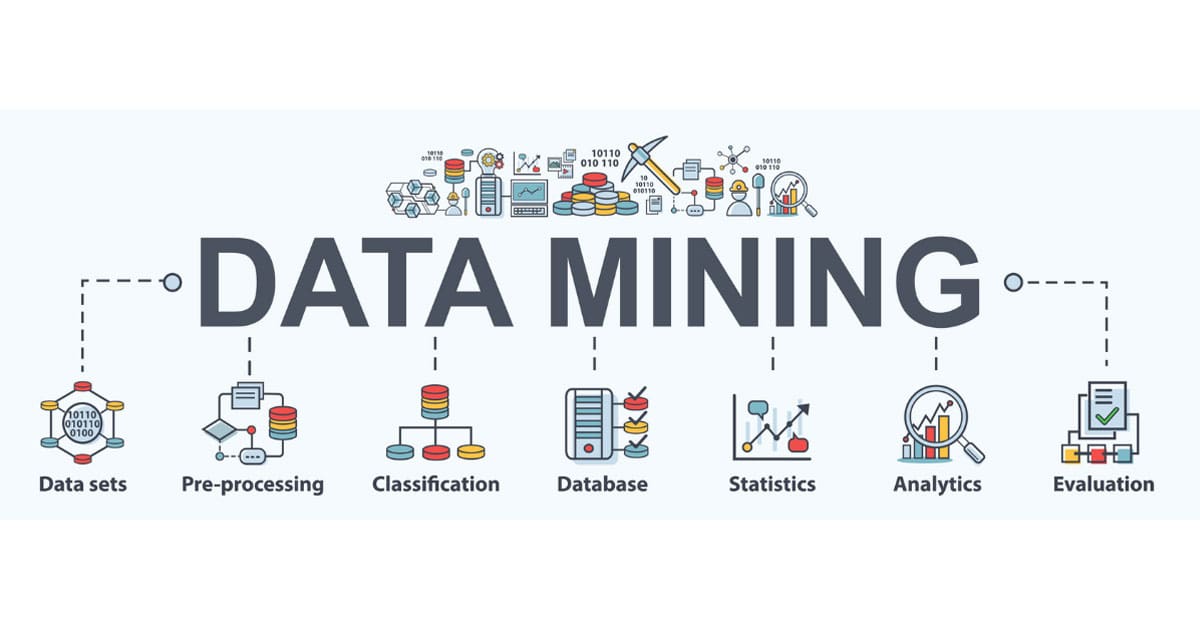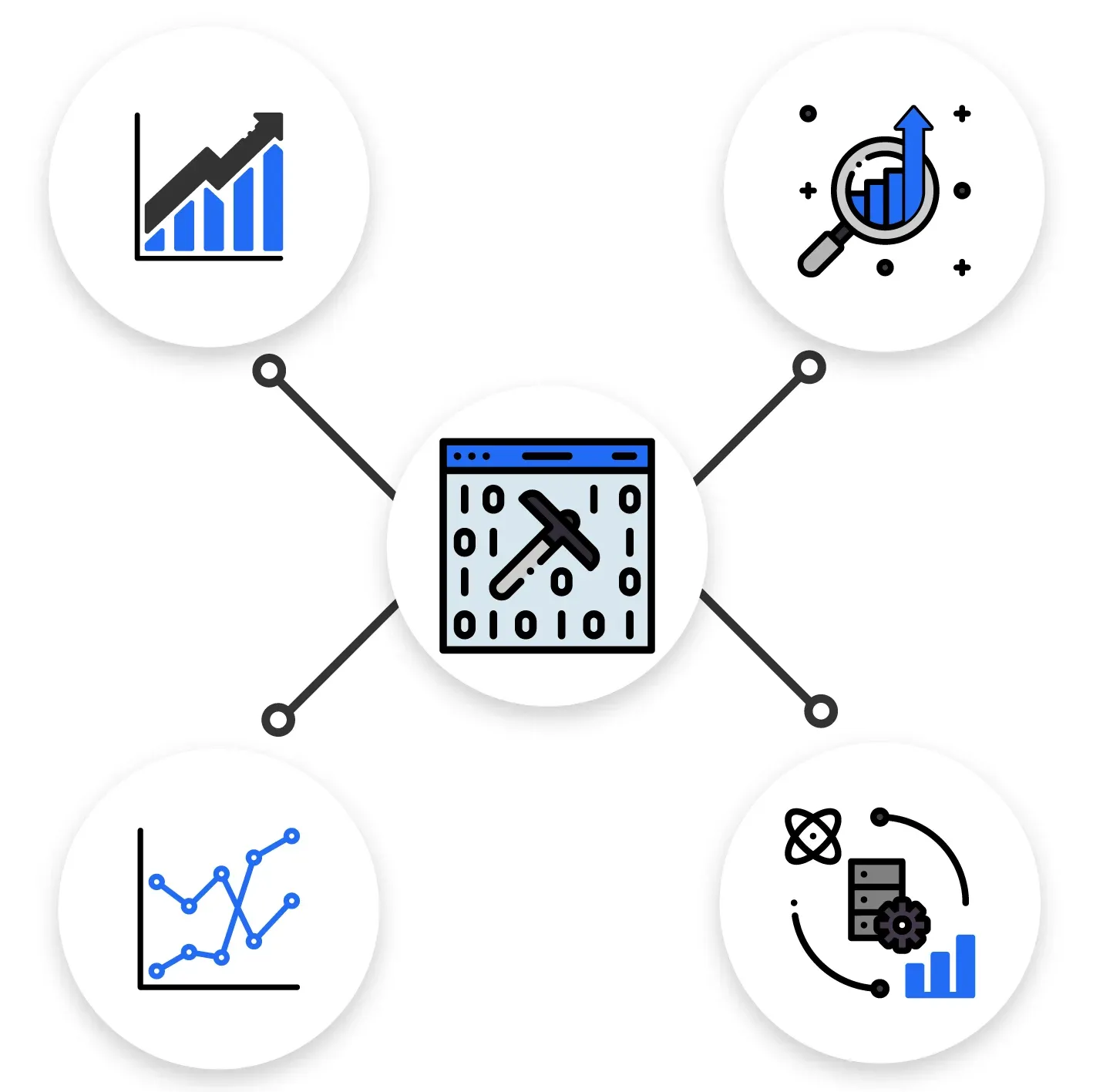Introduction to Data Mining
What is Data Mining?

Data Mining is the process of discovering hidden patterns, trends, and insights from large amounts of data. It involves extracting useful information from datasets and converting it into an understandable structure for further use. This can include techniques such as clustering, classification, regression analysis, and association rule learning. Data mining can be used in various industries such as healthcare, finance, retail, and manufacturing.
How is Data Mining Used?
Data mining can be used for a variety of purposes, such as improving customer experience, fraud detection, predictive maintenance, and risk management. In healthcare, it can be used to identify patient groups with similar conditions and to predict the effectiveness of treatments. In finance, data mining can help detect fraud and predict market trends. In retail, it can help optimize inventory and improve customer targeting.
Benefits of Data Mining
The benefits of data mining are numerous. It can help organizations make informed decisions, improve efficiency and productivity, and gain a competitive advantage. By uncovering patterns and insights in data, organizations can better understand customer behavior, market trends, and operational processes. This can lead to improved performance, reduced costs, and increased revenue.
Types of Data Mining
1. Descriptive vs. Predictive Data Mining

Descriptive data mining techniques are used to summarize and describe the characteristics of a dataset, such as mean, median, mode, and standard deviation. Predictive data mining, on the other hand, uses historical data to predict future outcomes or behaviors.
2. Classification
Classification is a type of supervised learning that involves dividing a dataset into distinct classes or categories based on specific characteristics or features.
3. Clustering
Clustering is an unsupervised learning technique that involves grouping similar data points or objects together based on their similarities.
4. Association Rule Learning
Association rule learning is a technique that involves identifying relationships and patterns between different variables or attributes in a dataset, such as "people who buy product A are likely to buy product B."
5. Text Mining
Text mining is a technique that involves analyzing and extracting useful information from large volumes of unstructured text data, such as social media posts or customer reviews.
6. Time Series Analysis
Time series analysis is a technique that involves analyzing and modeling data over time to identify trends, patterns, and seasonality.
Data Mining Techniques and Algorithms
1. Decision Trees
A decision tree is a flowchart-like structure that is used to classify data based on a series of decisions or criteria. Decision trees are popular in data mining because they are easy to understand and interpret, and they can handle both categorical and numerical data.
2. Random Forests
Random forests are an ensemble learning method that combines multiple decision trees to improve the accuracy and robustness of the classification. Random forests work by constructing a multitude of decision trees at training time and outputting the class that is the mode of the classes (classification) or mean prediction (regression) of the individual trees.
3. Artificial Neural Networks
Artificial neural networks are a set of algorithms that are modeled after the structure and function of the human brain. Neural networks are used for a variety of data mining tasks, including classification, regression, and clustering.
4. Support Vector Machines
Support vector machines (SVMs) are a type of supervised learning algorithm that can be used for classification and regression tasks. SVMs work by finding the hyperplane that maximally separates the data into different classes.
5. K-Nearest Neighbors
K-nearest neighbors (KNN) is a type of instance-based learning algorithm that can be used for both classification and regression tasks. KNN works by finding the K nearest data points in the training set to a given test data point and using their labels to predict the label of the test point.
6. Naive Bayes
Naive Bayes is a probabilistic algorithm that can be used for classification tasks. Naive Bayes works by assuming that the features in the data are independent of each other and calculating the probability of a given data point belonging to a particular class.
7. Apriori Algorithm
Apriori algorithm is a popular algorithm used for frequent itemset mining and association rule learning over transactional databases. It is used to find sets of items that frequently occur together in the data and use these patterns to make predictions or suggest recommendations.
Suggested Reading:
Batch Processing
Data Mining Tools and Technologies
1. Open-Source Data Mining Tools
Open-source data mining tools are software programs that are freely available for use and modification by anyone. These tools can be used to extract valuable insights from large datasets without incurring the high costs associated with commercial software. Examples of open-source data mining tools include KNIME, Rattle, and Weka.
2. Commercial Data Mining Software
Commercial data mining software is software that is developed by companies and sold to users. These tools often provide a user-friendly interface that allows for easy data analysis and visualization. Some examples of commercial data mining software include SAS, IBM SPSS Modeler, and RapidMiner.
3. Cloud-Based Data Mining Solutions
Cloud-based data mining solutions are software applications that are hosted on a remote server and accessed via the internet. These tools allow users to analyze and visualize data from anywhere with an internet connection. Examples of cloud-based data mining solutions include Microsoft Azure Machine Learning, Google Cloud AI Platform, and Amazon SageMaker.
4. Big Data Platforms
Big data platforms are tools that are designed to handle large and complex datasets. These platforms allow users to store, process, and analyze massive amounts of data in a distributed computing environment. Some popular big data platforms include Apache Hadoop, Apache Spark, and Apache Flink.
Best Practices for Data Mining
1. Data Cleaning and Preparation
The first step in data mining is to ensure that your data is clean and well-prepared. This involves identifying and correcting any errors, filling in missing values, and transforming your data into a format that is suitable for analysis. It's important to be systematic in your approach to data cleaning and to document all of the steps you take, so that you can reproduce your results later.
2. Feature Selection and Dimensionality Reduction
Once your data is clean and prepared, the next step is to select the most important features for analysis. This involves identifying which variables are most relevant to the problem you are trying to solve and removing any redundant or irrelevant features. Dimensionality reduction techniques, such as principal component analysis (PCA), can also be used to reduce the number of features in your dataset while retaining the most important information.
3. Model Selection and Evaluation
After selecting the most important features, the next step is to choose an appropriate model for your data. This involves selecting a machine learning algorithm that is suited to the problem you are trying to solve and tuning its parameters to optimize performance. It's important to evaluate your model's performance using appropriate metrics, such as accuracy, precision, recall, and F1 score, and to use cross-validation techniques to ensure that your results are robust.
4. Interpreting and Communicating Results
Once you have built a model that performs well on your data, the next step is to interpret and communicate your results. This involves visualizing your data and model outputs in a way that is easy to understand, and using statistical techniques to identify patterns and relationships in your data. It's important to communicate your results clearly and effectively to your audience, using language and visualizations that are appropriate for their level of expertise.
5. Ethical Considerations in Data Mining
Finally, it's important to consider the ethical implications of your data mining activities. This includes ensuring that your data is collected and used in a way that is fair and unbiased, protecting the privacy and confidentiality of individuals in your dataset, and ensuring that your models do not perpetuate or exacerbate existing social biases or inequalities. It's important to be transparent about your data sources and methods, and to seek informed consent from individuals before collecting or using their data.
Suggested Reading:
Data Transformation
FAQs
1. What is Data Mining and its purpose?
Data Mining involves extracting valuable insights from large datasets using techniques like pattern recognition and machine learning. It helps businesses make informed decisions and discover opportunities.
2. Which Data Mining techniques are commonly used?
Common Data Mining techniques include classification, clustering, association rule mining, anomaly detection, and regression analysis, each serving different purposes in data analysis.
3. How is Data Mining applied in marketing?
Data Mining helps marketers with customer segmentation, targeted advertising, churn prediction, and understanding customer preferences to enhance marketing strategies and sales.
4. What role does Data Mining play in finance?
Data Mining assists finance professionals in credit scoring, fraud detection, risk management, and investment strategy optimization, improving financial decision-making.
5. What are key challenges in Data Mining?
Key challenges in Data Mining include handling large data volumes, ensuring data quality and accuracy, addressing privacy concerns, and managing algorithm complexity.

